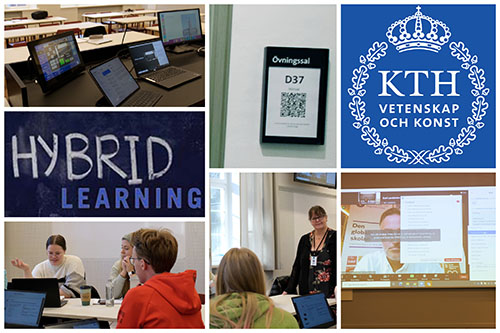Department of Learning Hybrid Pilot tests future of Hybrid teaching

A Hybrid pilot study was done at KTH (Royal Institute of Technology), which included teachers, educational developers, and technicians who in several ways supported, followed and evaluated the pilot project.
Hybrid Pilot study
The 2021/22 Hybrid Pilot study is intended to explore the concept of hybrid teaching arrangements for faculty members and students, providing the ability to teach and learn both on campus and from a remote location.
Hybrid learning environments
The Hybrid learning environment combines face-to-face learning with simultaneously streamed remote instruction, sometimes called blended synchronous learning, and sometimes called Hyflex learning. In-room and remote students can see and hear each other and interact through standard collaborative methods (e.g. chat and online documents).
KTH hybrid classroom technology
Hybrid classrooms use technology — including microphones, document cameras, and touchpads — to capture real-time instruction.
The KTH technicians have set up several lecture halls and classrooms to easily conduct video meetings with Zoom. Over 50 classrooms have document cameras installed to give the opportunity for the teachers to write on paper to everyone in the room and in Zoom, the lecture halls have built-in video conferencing systems. A handful of rooms are fitted out with a classroom camera and ceiling audio equipment so students working online can see and hear what is happening just as well as can students sitting inside the classroom. A member of IT support staff is always available before and during the lecture ready to provide in-room support for the teachers.
Faculty teacher stories
Faculty pilot participants have shared their experiences, including the benefits and things they struggled with while using the Hybrid classroom methods.
See the full story and recorded online seminar Teacher stories:
Teacher stories: Experiences of hybrid teaching
(In swedish)
Pedagogical implications
It is likely that changes to pedagogy will need to be made to maximise the benefit of Hybrid teaching. The first focus of this pilot study has been to deliver the technical solutions for hybrid teaching in conjunction with the pilot teachers' requests, who will then lead on, with educational developers, the associated impact on pedagogy. It has been said that a switch to a hybrid format is often a process where it can be good to let it take time to be able to review the layout and introduce improvements where it suits the content.
Student’s feedback
Many cited the flexibility and having a choice for learning environments. What has been most noticeable is the enthusiasm shared by the students who were able to resume in-person learning in the autumn.
Here is a short film on what the students say about learning in a Hybrid classroom format:
Students' experience of Hybrid teaching-(In Swedish with English subtitles)
